Batteries Not Included
A blog focused on cameras with no batteries - and the photos they take
Note: This blog is optimized for use with Mozilla Firefox - the best, free internet browser there is
Note: This blog is optimized for use with Mozilla Firefox - the best, free internet browser there is
Friday, March 12, 2010
Monday, May 25, 2009
Some items still for sale
Wednesday, June 25, 2008
Cameras and Camera Accessories to sell:
Note: Cameras are rated from a collector’s perspective but all cameras are in good working condition and ready to take photos unless otherwise stated.
Note: Actual shipping cost from zip 94114 will be added.
Note: Most Olympus cameras can come with the original leather case for free if you want it.
Cameras
Olympus 35 LC, Great cosmetic and working condition, $65
Olympus 35 LC Great working condition, dirt spot on back, faint scratches, $45
Olympus 35 LE, Good condition, works. Some scratches, $60
Olympus 35 EC-2, Good condition, small scratch on lower left, $30
Olympus 35 ECR, Excellent cosmetic and working condition, $25
Olympus 35 ECR, Dent on top, not tried if it’s working, $10
Olympus 35 EC Chrome, Good looking, works well, $30
Olympus 35 EC BLACK, Gorgeous, like new, $50
Olympus 35 SP Chrome, Great condition, some scratches on bottom, $75
Olympus 35 SP BLACK, Beautiful condition but with SSN on bottom, $165
Olympus 35 SP BLACK, Very faint paint loss on edges, VERY nice $180
Olympus 35 UC, VERY RARE, some scratches on back, $300
Olympus 35 UC, VERY RARE, some dirt stains, scrachecs, $220
Olympus Trip 35 Chrome, Nice condition, never actually used it, $25
Olympus Trip 35 BLACK, Gorgeous in original box and papers, like new, $125
Olympus Quickmatic EEM,Very good condition, wide lens, $15
Olympus OM-4 BLACK, Gorgeous – but is NOT working and missing timer release lever, $50
Olympus 35 ED, Light scratches and paint loss on rear, $35
Canon VT deluxe, Gorgeous. [Sold as a kit, see below] $500
Graphic 35 Like NEW w/box and all accessories, $60
Zeiss Ikon Ikomatic A Works but poor to fair condition. $10
Contax IIIa kit Gorgeous w/ a lot of stuff (see end of doc) $600
Links for various cameras showing what they look like and/or how the photos they took came out:
ECR: http://silfver.blogspot.com/2006/11/olympus-35-ecr-abandon-all-control.html
Graphic 35: http://silfver.blogspot.com/2007/07/got-myself-graphics-35-camera-but.html
Graphic 35: http://silfver.blogspot.com/2007/06/push-it.html
Trip 35: http://silfver.blogspot.com/2007/01/what-trip-part-2.html
Trip 35: http://silfver.blogspot.com/2006/12/what-trip.html
Olympus 35 SP: http://silfver.blogspot.com/2006/09/shooting-with-olympus-35spn_17.html
Canon VT deluxe: http://www.pbase.com/rsilfverberg/image/42888241/medium.jpg
Black OIympus 35SPs: http://www.pbase.com/rsilfverberg/image/43605959.jpg
Olympus 35 LE: http://www.pbase.com/rsilfverberg/image/42112475.jpg
Filters
Note: The 19mm filters are the very rare screw-in filters that fits the old SM Elmar 50mm lens and allows you to change the aperture without taking the filter off.
For more information see links at the bottom of this section
Note: All filters with no scratches unless otherwise noted.
Note: I am not sure what the 9mm (?) filters are used for but some time ago someone suggested that they are for a rare 3D viewer that Leitz came out with in the 30’s.
Leitz 19mm, yellow, #1, FIRHE w/ original box $60
Leitz 19mm yellow, #1, FIRHE $45
Leitz, 19mm yellow #1, FIRHE $45
Leitz 19mm, yellow #3, FINUS $65
Leitz, ELPET, in box, $20
Leitz ELPIK, in box, $20
Leitz 9mm (?), yellow, marked ‘1’, $30
Leitz 9mm (?), clear, marked ‘F’, $30
Leitz, chrome ring, green GGr (fits a Canon 50/1.4 perfectly), $30
Leitz, screw-in, orange #3, black ring (smaller than for a 50mm) $15
Leitz Clamp-on, green, in black ring $10
Leitz, screw-in, dark red (Rh) $10
Leitz, Yellow/Orange #3, slip-on, $10
Leitz, Yellow/Orange #3, screw-in, $10
Canon 40mm, Yellow #1, Chrome ring $25
Canon 48mm, Skylight $10
Canon 48mm, SKY-1A, Black ring, original box, $12
Heliopan, 40x0.5, UV 0, in original box, $25
Heliopan 48mm, UV ES, Slim version, in original box, $25
Hoya 48mm Y [K2], in box, $5
Note: Since I don’t know the filter size for items 32-36 I can sell them all (five) in one package for $40.
Links for some of the filters mentioned above:
FIRHE: http://silfver.blogspot.com/2006/09/firhe-good-things-come-in-small.html
FIRHE/FIRMY: http://silfver.blogspot.com/2006/09/firhe-joined-by-firmy_27.html
ELPET/BEOOY: http://silfver.blogspot.com/2006/11/getting-closer.html
Hoods:
Canon, Chrome metal, Series VI (50/1.8, 35/2.8, 35/3.2) $25
Canon (same as #43) with a stuck(?) Series VI 34mm ring $10
Canon square, black, plastic, Series VI (50/1.9, 35/3.5) Great. $30
Leitz, VALOO, Black, great condition $55
Leitz, FIKUS, (Elmar 5,9,13.5 cm), Black and chrome, $45
Leitz, FISON (Elmar), chrome, great condition, $40
Black S-50 hood (fits Canon 50/1.4 for instance) $15
Zeiss Ikon, Chrome, 1110 A28,8, really beautiful and rare $35
Mamiya hood for 75/3.5 lens for the Mamiya 6/6MF camera $45
Black, no-name, metal hood, 55mm $8
Links for some of the hoods:
Square Canon hood (#45): http://k53.pbase.com/u14/rsilfverberg/upload/41784140.canon_deluxe8.jpg
S-50 hood (#49): http://k53.pbase.com/u11/rsilfverberg/upload/42740140.s50.jpg
Chrome Canon hood (#43/44): http://k41.pbase.com/u11/rsilfverberg/upload/42740136.canhood1.jpg
Accessories/Various stuff:
Leitz, Plastic cap, 50mm, $5
Leitz, red, unmarked box, fits 19mm filters, $5
Cabin small light panel (CL-5000P) (does not come with the A/C): $50
Olympus, Black plastic lens caps (for 35mm fixed RF cameras) x 2 $5/each
Flexameter, unusual!!, original leather case but seams are open $50
Canon RF external lightmeter. Looks GREAT. Didn’t fit. $45
Canon leather case for 4-5 filters (older), brown $10
Canon leather case for 4-5 filters (older), brown $10
Canon leather case for 4-5 filters (older), black $10
Canon chrome Series VI ‘stepup/down(?)’, 42mm $8
Leitz, BEOOY kit in original red box $35
Leitz, ELDIA in original red box(!) $25
Leitz, flash for M3 WITH the holder under the camera $45
Leitz, Elmar 90/4 lens. Hazy. I didn’t like it at all. Comes w/ caps $25
No-name rear cap. Fits the Elmar 90/4 for instance $3
Leitz, NOOKY for Elmar (SM) $40
Olympus PS200 Flash, Gorgeous condition $25
Great looking leather camera strap “Joseph Kussac” $25
Canon, external viewfinder, 50mm. Great. $55
Canon 50mm screw-in to clamp-on converter ring chrome $25
Canon Series VI 40mm chrome ring $5
Canon RF 50/1.4 lens in GORGEOUS condition w/ original cap $225
Canon RF 50/1.8 lens in also GREAT condition $100
Batteries: KS76 1.5V (SR44) “Best by 2006” (two of them) $4
Batteries: Z675PX 1.4 Zinc Air unopened (two of them) $5
PEAK Loupe, 4x magnification, no skirt. $15
Ragnar Axelsson’s “Faces of the North” book. Signed. $35
Leitz. Parts of focotar set. $15
Leitz MR lightmeter for M3. May well be broken & some scratches $10
Flashbulbs (about 100). Mostly M3 bulbs like Sylvana. Nice boxes $25
Sigma lens. For Canon EOS. 70-300/4-5.6 APO Macro Super $50
Links for some of the accessories mentioned above:
Product information for Cabin light box CL-5000P: http://www.adorama.com/catalog.tpl?op=detailsdisc&sku=VRCLB45
(If you want to buy the A/C for it the product # for that is 601101)
Canon Light Meter (#58): http://www.pbase.com/rsilfverberg/image/43050125
Canon Light Meter (#58) http://www.pbase.com/rsilfverberg/image/43050126
NOOKY: http://silfver.blogspot.com/2006/10/getting-some-nooky.html
ELDIA: http://silfver.blogspot.com/2007/01/eldia-interesting-and-quirkybut-is-it.html
VALOO: http://silfver.blogspot.com/2006/04/valoo-coolest-hood-ever.html
Focotar set (parts): http://www.pbase.com/rsilfverberg/image/57992735.jpg
Flexameter: http://silfver.blogspot.com/2006/03/its-birdits-planenoits-flexameter.html
Flexameter: http://www.pbase.com/rsilfverberg/image/57275531
Flexameter: http://www.pbase.com/rsilfverberg/image/57275533
Flexameter: http://www.pbase.com/rsilfverberg/image/57275535
Flexameter: http://www.pbase.com/rsilfverberg/image/57275537
Flexameter: http://www.pbase.com/rsilfverberg/image/57275539
Elmar 90/4 (shows on camera): http://silfver.blogspot.com/2006/01/leica-iii-f-obsession-continues.html
Elmar 90/4: http://k53.pbase.com/o4/75/184875/1/54279560.leicaiii_finder5.jpg
BEOOY: http://silfver.blogspot.com/2006/11/getting-closer.html
Leitz, flash mount and flash: http://www.pbase.com/rsilfverberg/image/38740719
Canon, external viewfinder: http://www.pbase.com/rsilfverberg/image/41784140
Canon 50/1.4 lens: http://www.pbase.com/rsilfverberg/image/42593109
Canon 50/1.4 lens: http://www.pbase.com/rsilfverberg/image/42593113
Camera kits:
Contax IIIa color dial camera kit, All in GORGEOUS condition (see picture link below)
Kit includes;
Contax IIIa camera in wonderful condition,
Sonnar 50/1.5 lens (email for samples of photos taken with it!!),
Black leather half-case from Luigi,
3-4 original Zeiss filters for the Sonnar (some with in their original Bakelite boxes!)
External Zeiss 50mm viewfinder (VERY rare. Missing one screw on its foot that can be replaced rather easily)
Original Zeiss hood for the Sonnar.
For the entire Contax IIIa kit: $600
Canon VT deluxe: Truly a gorgeous kit and that goes for camera body as well as the accessories. Many things looks like-new.
NOTE: EVERYTHING works fine with one exception: The rangefinder spot in the camera tends to fade in and out – or disappear. I have emailed with DAG and his assessment, without having seen the camera is that a glass element may need to be replaced and estimated a $50-75 repair cost. Since this is unconfirmed I am selling the camera with that disclaimer and that is also why you are seeing this kit at a lower price than what this beautiful package would normally fetch.
Kit includes:
#19 - Canon VT deluxe (see description above) $175
Original Canon leather case that supports the rapid winder $15
#31 - Leitz, chrome ring, green GGr (fits a Canon 50/1.4 perfectly), $30
#49 - Black S-50 hood (fits Canon 50/1.4 for instance) $15
#71 - Canon, external viewfinder, 50mm. Great. $55
#72 - Canon 50mm screw-in to clamp-on converter ring chrome $25
#74 - Canon RF 50/1.4 lens in GORGEOUS condition w/ original cap $225
#75 - Canon RF 50/1.8 lens in also GREAT condition $100
For the entire Canon VT deluxe kit (all 8 items listed above): $525 – or pick the items you want
(I was asked to break out the kit items for individual prices as well so they are listed for each item.
The #’s refer to the numbers in the document where the items are also listed individually).
Contax IIIa photos: http://www.pbase.com/rsilfverberg/contax_iiia
Canon VT deluxe photos: http://www.pbase.com/rsilfverberg/canon_vt_deluxe
Tuesday, July 24, 2007
The Big Sale
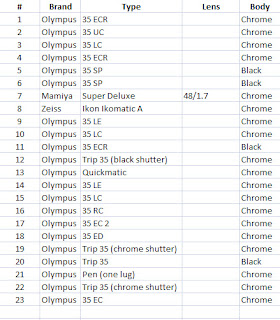 Click to enlarge
Click to enlargeThese are the cameras that have taken many of the photos featured on this blog and even though it will be hard to let some of them go I am hoping that they will go to people that will appreciate them and put them to better use than what I have lately.
I am going through boxes to match up cases, caps, etc to the cameras and should be able to start selling them off within a few days.
All cameras are in great working order (meters, etc) as well as cosmetic condition.
Photos of the cameras for sale are posted here: Cameras For Sale
Stay tuned for more and if there is any camera that you may be interested in drop me a note.
Wednesday, July 18, 2007
Just a few photos
Monday, July 02, 2007
Got myself a Graphics 35 camera, but....
Its rather unique push-focusing mechanism and classic looks intrigued me and it was not long until I was the happy owner of a mint copy of this odd camera. Heck, it even came in the original box from the 50's along with all possible accessories - all in unused condition. Things couldn't be better. But, then I decided to...use it.
This is a horrible camera. There is no way around it. It sucks.
Let's see, what didn't I like;
a) Weight. It's heavy. It weighs more than my Leica M3,
b) Focusing. My initial fascination with the very unique focusing system quickly turned into frustration over what in reality was a rather poor ergonomic design choice.
c) Viewfinder. One small window for rangefinder focusing and a slightly larger viewfinder for composition. The focusing window is potentially the smallest one I have ever seen and is even further reducing the pleasure of using this camera.
d) Shutter speed range. Fastest shutter speed is 1/300. Enough said.
e) The shutter. After advancing the film the shutter needs to be manually cocked. Something I kept forgetting and caused me to miss the shot I had intended to take. In addition to this the shutter release is located on the front of the camera and, this is ingenious..., is a lever that you pull to the right. So after you have focused the shot you move your finger down to the lever and pull it outwards, to the right. Fantastic.
f) Film frame counter. It's manual in that you have to set it to the number of frames of the film. Minor inconvenience taking the above into consideraration.
What did I like;
a) The lens. The camera I got has the slower f/3.5 lens but it performed fairly well in a number of situations both inside as well as outside. It was the one really positive surprise.
b) Hm. Nothing else really.
Below are some sample photos taken with the camera that shows that it does have the ability to render light and dark onto a strip of film.
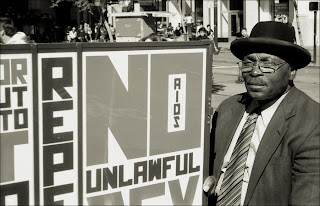

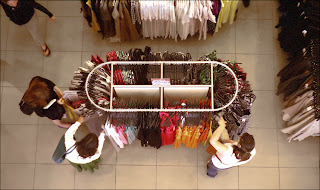
Away it goes
Now, I'm sure that different people 'bond' differently with different cameras so it may well be that there is someone out there that would love to own - and use - this rather unique piece of... so I'm more than willing to sell mine to anyone that think that they can give it a good home.
The camera came is in near un-used condition (wonder why...) after having had two rolls of film through it. It comes with the original colourful paper box, original flash, leather case, wrist strap and shoulder strap. All in mintish condition. I paid about $60 for the whole package including shipping and would be more than happy to let someone else suffer with it for the same price.
Tuesday, June 19, 2007
Choose Film
Sites dedicated to film are not very common these days and it triggered me to sit down 'virtually' with Mr Jerry Deeney - a very friendly and accommodating representative from Fujifilm UK - to ask him some questions about the site - Choose Film.
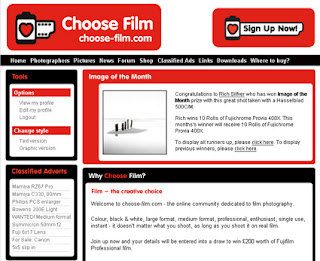
Q: Good morning Mr Deeney. What is your position within FujiFilm UK?
A: "I'm the Marketing & Business Development Specialist for Professional Imaging, Fujifilm UK Ltd…which basically means I look after all of the marketing activity for the Fujifilm Professional film range in the UK. "
Q: It does not take long to realize that there are some very strong ties between the site Choose Film and Fujifilm. Who is behind the site - is it owned or sponsored by Fujifilm?
A: "We at Fujifilm UK created the site and Choose Film is fully owned by Fujifilm UK Ltd. "
Q: When did Choose Film open up:
A: "We launched Choose Film at the Focus-on-Imaging photo trade show in Birmingham, UK at the beginning of March 2007. "
Q: Why a site dedicated to film now? What triggered the idea of this site?
A: "We wanted to build a community for photographers that shoot on film. Everyday we speak to photographers who are tired of constantly being force fed that digital photography is better. Many of the magazines and photographic stores are spreading rumours that are frankly not true about the discontinuation of certain products and the demise of film photography. We wanted to quash these rumours and to build a home on the Internet where photographers could help to answer each others questions on film. Buy and sell film camera equipment, find film suppliers, second-hand film cameras and decent processing labs, show off their own work to the world and to generally have the knowledge that Fujifilm are still 100% behind film.
We are often asked why choose film is ‘non-Fuji’ branded. The reason is that we want Choose Film to stand on its own. We openly encourage members to upload any images shot on any brand brand of film. The site is a celebration of all things film. If we imposed ‘Fujifilm only’ rules, I think it would have spoiled the whole ethos of the idea."
Q: So it would be fair to say that Fujifilm continues to see a future for film in this increasingly digital world?
Q: "Absolutely! There will always be a market for film.
It has obviously become more of a niche market over the last few years. But, those that have gone digital for practical reasons – news, sport etc, went digital years ago. Film is a choice now, hence the name – ‘choose film’. It is a creative choice. People that choose film are choosing it for quality not for convenience."
Q: On that note, are there any planned, future releases of either new or updated emulsions from Fujifilm?
A: "Fujifilm Professional has released eight new emulsions in the past two years. The latest this year being the new Fujichrome Velvia 50 and the new Fujichrome Provia 400X films. The total number of films in our Professional and Consumer range is currently 27 different emulsions."
Q: What can you tell us about the future plans for Choose Film?
A: "We are never short of ideas for choose film. We are currently developing more functionality options for the members personal profile pages; we want to create a tighter network between the members, so that members can find other photographers with similar interests or that are local to each other.
We have a number of competitions and promotions planned for the year, which will be exclusive to the members of Choose Film"
Q: Are you yourself a film user and if so what is your choice of gear - and film?
A: "Yes, of course. I have been using film and film cameras for 20 years.
My current favourite is my Lomo LCA camera. For me, there is something about its unique polariser and vignette built into the lens that cannot be beaten. As for film, I don’t need to look any further than Fujifilm. For neg, I mainly use PRO400H, for Black & White – Neopan Acros 100 is an unsung hero, one of the finest black & white films on the market. For transparency it’s the new Velvia 50 for contrast and saturation or Astia 100F for subtlety and skin tones."
Q: Thanks again for the opportunity to find out more about the site and Fujifilm's plans for it. Any closing comments?
A: "We were quite overwhelmed by the response of Choose Film. We initially launched the site to the UK market, but quickly realised that the Internet knows no boundaries.
We found it very refreshing to hear from photographers all over world that they still love using film. No matter what Country, photographers are faced with the same problems – being forced by magazines to ‘go digital’ and finding a lack of support for film from the places it once thrived.
We hope that Choose Film can address some of these problems and can help its members to continue using film.
Choose Film is still only less than three months old, yet we have nearly 3,000 members signed up from all over the world. We feel there are many exciting things to come. Film technology is getting better everyday and our latest emulsions are best we have ever had.
For Choose-film.com and its members, this is just the beginning."
So, if you like me still enjoy the use of film - and appreciate seeing others working with that media - then take a moment and check out this new site and see what it has to offer.
Saturday, June 09, 2007
The Soft Touch
But seeing as it was a gift and that I was also pretty sure that I would lose it if I didn't do something with it I promptly attached it to my Leica M3's shutter release button and thought little or at least close to nothing about it. I did have a few lost shots as the Softie makes the shutter easier to trigger by accident due to it being a bit more elevated and more sensitive but I still kept it on the camera for months as I didn't feel that it was too much of an intrusion.
Then, earlier today, when walking around with my Leica in hand snapping random street scenes I suddenly realized that I had lost the Softie. This in itself was not that unexpected as one of the challenges with at least my Softie was that it had a tendency to come loose and I had more than once found it rolling around in my camera bag. What surprised me, right there on the street, more than the actual loss - was the realization that I really missed it.
Especially when shooting street scenes with the camera at waist level (which granted is more 'fun' and any good results are of the gratuitous kind) I found that having the Softie in place made it so much easier to take the photos as I tend to press the shutter with the mid-part of the finger instead of the finger-tip in those situations.
So backing up a bit and to answer something that some people may be asking themselves - what is a Softie?
A Softie is the commonly used term for Camera Soft Release Button. It can be flat, concave or convex and screws into the camera's regular shutter release button providing a elevated shutter button with, often, an increased surface area. Some people claim that by using one they are able to handhold their cameras up to an additional full stop but the most commonly perceived benefit is to be able to squeeze of the shot using the mid-section of your finger instead of the tip of it (that and 'comfort' which obviously is a matter of taste).
There are a number of soft release buttons currently manufactured and sold and if your camera's shutter release button accepts the attachment of a cable release then odds are you would be able to use one of the many available soft release buttons out there.
One of the more popular sources is for instance Luigi's concave and convex softies available on his Leicatime site.
Tom Abrahamsson of Rapidwinder also offers the dome shaped soft release button - and in a number of different colours. Tom also manufactures and sells the 'Minisoft release' that fits a number of additional cameras such as the Rolleiflex and the Olympus OM series.
So who 'invented' the soft release button - and when?
I have honestly no idea and would be interested in hearing from anyone out there that may know the answer. One of the oldest soft release buttons that I know of is Leica's OZTNO (part number 14088) that was manufactured around 1955:
But even before that one Leitz produced a soft release 'dome' for their Barnack cameras back in the 1930's which could be the first commercially available soft release button:
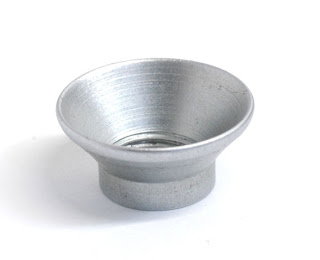 (I'd be interested in learning more about the Leica part code for this contraption as well if there is anyone out there with information about it).
(I'd be interested in learning more about the Leica part code for this contraption as well if there is anyone out there with information about it).Bottom Line: If you haven't used a 'Softie' before you may want to spend the ten dollars or so that it will cost you just in order to see if it something that works for you.
I didn't think I would ever find the need for one but after today's loss I must admit I am planning to replace mine as soon as possible as my Leica now feels 'incomplete' without one.
Monday, June 04, 2007
Push it!
The one I handled at the fair was fairly beaten up and had some parts missing but what intrigued me about it was the focusing mechanism - both how it worked internally as well as externally.
The image through the viewfinder is split horizontally. Pushing two buttons located on either side of the lens moves these two images until the two halves are lined up. Pretty much like a rangefinder split image but - different.
See an illustration attempt below for how the view through the viewfinder looks like:
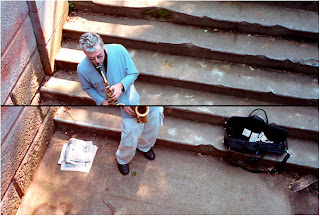 Line up the horizontal slices to focus your photo
Line up the horizontal slices to focus your photoBelow are some of the ads used to introduce this camera to the public in the mid-to-late 1950's:
F/3.5 (single color band): Feb 1955 - Apr 1956
F/3.5 (double color band): Apr 1956 - May 1957
F/3.5 (universal color band): Apr 1956 - July 1957
F/2.8 (double color band): Nov 1955 - Apr 1956
F/2.8 (universal color band): Apr 1956 - July 1957
But even with a number of updates the camera never really hit it big with the public and was discontinued no more than three years after its introduction in 1955.
Now, I didn't buy the one that I found at the fair but having read up a bit on this somewhat quirky camera I must confess that I'm considering picking one up at some point in the future. If I do I'll be sure to post a more thorough user experience here along with samples of how well (if at all) it works.
eBay prices fluctuates from $20 to $200 depending on condition and accessories.
If you find one in good condition and for a good price it may well be worth getting one just for the 'push focusing' experience :)
Wednesday, May 16, 2007
Looking back - and forward
From a photographic perspective I think I ended up in the proverbial slump that many of us may find ourselves in from time to time.
The 'easy' way out would had been to revert back to a gear-focused mind-set 'If I only had another camera body', 'I would do so much better with a wider lens', 'I need a smaller kit so I can carry it with me in my pocket at all times', etc, etc... None of those reasonings are particularly wrong or ill-thought out but if you spend too much obsessing about what you have - instead of using what you do have - you will end up chasing that magic bullet as all possible photo opportunities passes you by.
Having said all that let me now crawl to the cross to confess that I am considering a change in gear.. Well, maybe not as much a change as an addition.
I have used manual rangefinder cameras almost exclusively for the past three-four years or so. I love the way they operate, look and the results they can produce but there have also been so many occasions where I felt limited in what I could reach for photographically.
A 35mm rangefinder camera has a realistic FL reach between 28 and 90mm. Sure, some go wider and longer but it's within this range that most people end up. Including me.
I started thinking about the camera I used when I got into photography as a hobby back in 1997-98 - the Canon A2e (or EOS5 depending on where you live).
It was a auto-zoom, eye-focus assist, auto-exposure SLR. Completely battery dependent and had a significant amount of plastic in its body. Thing is - I loved taking photos with it.
For a year I used nothing but a 50/1.8 lens on it and loved combining a bit of manual foot-zooming with the luxury of having the camera calculate the shutter speed for me and place the focus where I wanted.
Looking back at some of the photos I took then I see that they are not significantly different or even better than the ones I may take today but I remember the ease of taking them and the 'luxury' of taking a macro, zoom, super wide at the turn of the already equipped lens.
Some of the photos I dug out, from those days;
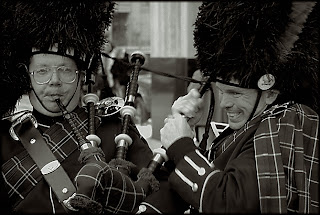 This was one of the first photos I was thinking about when looking back at my SLR-auto-everything days.
This was one of the first photos I was thinking about when looking back at my SLR-auto-everything days.I remember taking it at the St Patrick's day parade in Chicago around 1998-1999 and also I remember what a split second scene it was and how the auto-focus, auto-exposure and zoom didn't help me to take the photo but enabled me to. Had I been carrying one of my rangefinder cameras I would not had been to focus and take the photo before the moment had disappeared. Now, I place a huge emphasis on 'I' in the previous sentence as I am convinced that there are other photographers out there that would had been able to take this photo three times using a rangefinder camera - but I'm not one of them.
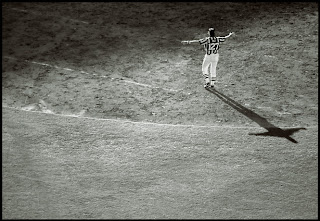 The above photo "American Religion" was taken around 2000 at a pre-season game between The Raiders and The 49ers. I was at the extreme long end of my tele-zoom at 300mm when I took this photo. Once again, something that I would not had been able to capture using my existing gear preference.
The above photo "American Religion" was taken around 2000 at a pre-season game between The Raiders and The 49ers. I was at the extreme long end of my tele-zoom at 300mm when I took this photo. Once again, something that I would not had been able to capture using my existing gear preference.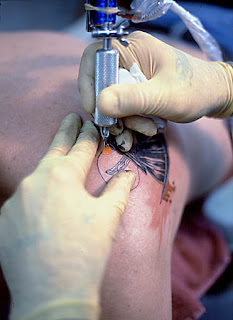 Taking this photo, in some late-night open tattoo parlor in Chicago, I greatly benefited from close focusing capabilities. The customer was a very drunken man all dressed up in a cowboy outfit and t this point he had already passed out. I remember asking the tattoo artist if he thought the customer would be surprised in the morning when he sobers up and his reply was 'Most of my customers are'.
Taking this photo, in some late-night open tattoo parlor in Chicago, I greatly benefited from close focusing capabilities. The customer was a very drunken man all dressed up in a cowboy outfit and t this point he had already passed out. I remember asking the tattoo artist if he thought the customer would be surprised in the morning when he sobers up and his reply was 'Most of my customers are'.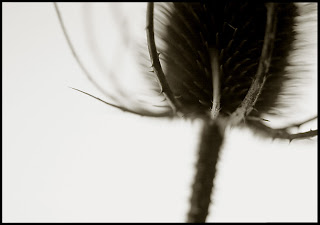 Another close-up/macro photo.
Another close-up/macro photo.Obviously not easily attainable using a rangefinder camera (possible - but not easily).
I had just moved to California and was at 'home' at a hotel room with a really bad cold. As I started to recover I got bored. Pulled out some weeds that I had picked up in Oregon during a road trip there and placed them on a lightbox, rigged up the camera on a tripod and stacked two or three close-focusing filters on the lens and shot away.
When my A2e eventually passed away after having been crushed in the overhead compartment on some flight I ended up not taking photos for a long time. I got back into the hobby a few years later after having acquired a Hasselblad and later a range of rangefinder cameras. While I truly have - and continue to - enjoy using manual cameras I also recognize that they come with significant limitations. I think part of my stubbornness from trying to force these cameras to be my only tools comes from knowing the history of them and how well they have been put to use throughout the past decades. If they were good enough for Henri Cartier-Bresson and Robert Kapa why would I need anything else?
I think this may be the core of an issue that many users of either/or rangefinder/classic cameras sometimes face.
If you fail to get images that excites you using such equipment it often triggers two responses;
a) buy more lenses/filters/bodies - because obviously it must be 'not enough gear' that is preventing you from achieving your goals - or,
b) seriously doubting your photographic capabilities and end up disillusioned and less inclined of picking up that M3/ZI/R2.
If the above applies then maybe you are just like me, being too stubborn in trying to fit that square peg into a much too round hole.
I will most likely keep my square pegs - but I am seriously looking at round-peg options to add to them.
Thing is, they will require batteries..
Sunday, March 11, 2007
Thursday, March 01, 2007
Dem Bones
Your neck bone connected from your shoulder bone,
Your shoulder bone connected from your back bone,
Your back bone connected from your hip bone,
Your hip bone connected from your thigh bone,
Your thigh bone connected from your knee bone,
Your knee bone connected from your leg bone,
Your leg bone connected from your ankle bone,
Your ankle bone connected from your foot bone,
Your foot bone connected from your toe bone,
I hear the word of the Lord!
I hear the word of the Lord!"
===============================================
Dem Bones, Johnson & Johnson
Tuesday, February 20, 2007
Thursday, February 08, 2007
To Crop Or Not
But where do you draw the line? Does excessive cropping in post-processing in any way diminish the value of the image? Is there a difference in cropping out unwanted elements vs cloning them out of the image? Both can have the power to remove unwanted elements that was there when the photo was taken. Is there a line and if so where is it and who draws is?
The above thoughts were triggered after having posted a photo on photo.net asking for cropping suggestions - not because I thought it was a particularly good photo in need of rescuing but rather because I find it interesting to learn what others may see in an image.
See below for the original photo - and some of the versions that people submitted:
Versions 1-3 shows the scene through alternative cropping excluding elements and changing the image format.
Version 4 takes it one step further by tilting the entire image creating a whole new perspective.
Version 5 goes even further - now with cropping as well as cloning out the distracting street scene in the lower right hand corner.
Are some versions more acceptable than others - and if so why and who decides that?
a) Is the image accurately represented?
This would be a concern mostly in editorials or historical representation of scenes and events.
Reuters just a few weeks ago came out with some updated ethical guidelines pertaining to post-processing activities: Reuters on 'the use of photoshop'
Reading through the guidelines and the comments that followed it's clear that even though Reuters considers cropping to be acceptable there are a number of voices that claims that cropping is just as much a deletion of elements in a photo that cloning it out is.
I'll leave that discussion to the professionals but take it down as 'cropping is OK in editorial work'.
b) Does cropping in post-processing lessen the 'value' of the image?
This is the perspective that I am personally more interested in.
Let's say you see a photograph you really like and one of the reasons is that you are really impressed by how the photographer was able to capture a certain scene.
You later find out that the image you saw was about 20% of the original photo as it had been heavily cropped in order to eliminate some distracting elements. Do you still like the photo? Are you less impressed by the photographer's abilities?
This comes down to how much importance you place on the process of getting a photo vs how much the final image is worth to you. Personally I must admit that part of why I like certain photos is because I know the steps the photographer must have gone through and admire the skills that are evident in the image (positioning and timing when taking the photo, wet darkroom skills, full-frame contact printing, etc). But in the example above does it matter of the person cropped it down to 20% in post processing or if he did it at the original scene by using a different lens? Does it matter if the photographer sees the final image in-camera or on-screen? This is one area where there are no guidelines as in the case of editorial photography. You simply have to make up your own mind about what is important to you.
One popular school of thought is that it's only the final image that matters.
If the photographer did the crop in the viewfinder or in photoshop doesn't matter as it's still the same person's vision that comes through in the image.
In the end I think it comes down to if you yourself is happy with the image you create - regardless of what post processing steps you took. You crop. I crop. Heck, Ansel Adams cropped.
My personal take is that I do consider cropping to significantly altering an image to the extent that I am always never as 'proud' or 'happy' with an image that I reached by cropping as I can be if I did it all through the viewfinder.
Part of this is because of wanting to push and challenge yourself (as well as a semi-luddite's view on photography) - and also appreciating that in others.
I'd be interested in hearing other people's thoughts on this.
Does cropping 'lessen' the value of the final image in your eyes (regardless if it's your photo or not)?
Is there a value in the process - or is it just the final image that matters?






















